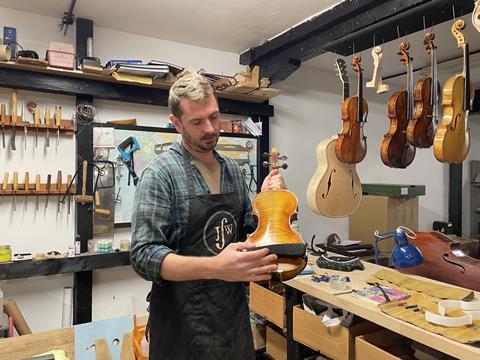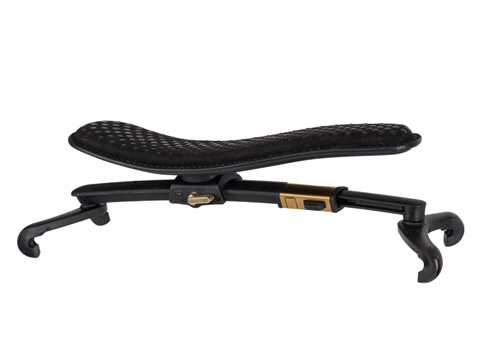Luthier John Francis Wright gives his opinion of the Kun Seven, a shoulder rest developed with both player and instrument in mind

A serendipitous encounter at the ESTA International Conference in April 2023 gave violin maker and professional violinist John Francis Wright, of Nottinghamshire’s Newark Workshop, the opportunity to test drive a new product few people had even seen. That device was an end-stage prototype of the new ’Seven’ shoulder rest from Kun, who were also exhibiting at the conference. John, who teaches at the Newark School of Violin Making, was struck by how little effect the shoulder rest had on the sound of one of his own violins.
’I’m not usually a fan of add-ons that claim to make an instrument sound better, so I’ve caught myself out here,’ John admitted.
In fact, Kun Seven was developed with both player and instrument in mind, tackling pivotal needs through innovative, contemporary design.
● A ratchet mechanism provides fine width adjustment so the shoulder rest can be attached and removed without the sliding that can compromise the violin’s delicate varnish.
● The bendable, cushioned pad, which can be manipulated to fit the shape of the player’s shoulder, doubles as a subtle cantilever, absorbing the pressure produced during play and minimising tension at stress points on the instrument’s edge.
● Triangular ribs in the hook of Kun Seven’s newly designed feet can accommodate a vintage violin with the narrowest of edges. The result is unwavering stability and uninhibited sound.

Eighteen months on and following the highly anticipated international release of Kun Seven, Kun Europe’s Marketing and New Products Lead, Aran O’Grady, and Marketing Assistant, Alejandra Gonzalez Gordon, visited John’s Newark workshop, where he shares a space with makers Antoine Gourdon and Carlos Libreros, to seek his perspective on the finished product.
The day kicked off with John using a Kun Seven on one of his own violins. He says he was immediately reminded of what impressed him so much the first time he tried it. The comfort and stability provided by the rest, coupled with an unaltered sound, gave him a distinct ease of playing.
John also tried removing the pad from the bridge to see if there was any difference in sound. He could hear no change, but of course he missed the pad’s comfort. In fact, the separation of the pad and bridge, aided by minimal contact of the feet, redistributes overall weight to the shoulder, reducing the impact on crucial vibrating areas around the edge of the instrument’s back plate.
His curiosity ignited about Kun Seven’s effect on sound projection, John quickly arranged an ad hoc visit to nearby St. Mary Magdalene Cathedral, one of England’s largest, to put this to the test. In the generous acoustics of the 12th Century architecture, the violin seemed somewhat amplified, and John commented that the vertices of the instrument felt more aloft, versus using no shoulder rest.
Hear the results for yourself:
’The violin doesn’t make any sound until you interact with it, but it’s by no means an inanimate object,’ John explains. Every choice a maker makes—from materials to thickness—imbues the instrument with ’bated breath, where it’s all sprung and ready to burst into life.’ But it is up to the player to make this sound happen, he says. For this to occur, the instrument’s set-up must be accessible. For the violin maker, the neck shape must be considered carefully, as it must be ’familiar and tactile’ in the left hand, while a shoulder rest should seamlessly connect the violin to the player’s body, allowing comfort, ergonomics, and acoustics to work in tandem to support this intimate relationship.
Wright’s final verdict on the Kun Seven: ’It’s unlike anything else in terms of adjustability and seemingly doesn’t impede the sound, resulting in an enhanced playing experience.’
A huge thanks to John Wright and the St Mary Magdalene Cathedral, Newark-on-Trent.











































No comments yet